Keeping electronics powered and fully charged while camping isn’t difficult… if you have the right gear!
However, depending on the type of camping you’re doing and the duration, some power options makes more sense than others.
The key is finding the right power and charging option that best suit your needs. So, let’s dive into the different charging options that are available and how they stack up against each other.
Camping Equipment Charging Requirements
I tend to carry minimal electronics while camping. But, anything I do end up bringing must be USB chargeable.
That’s because USB powered devices require low voltage (5 Volts) and low amperage (0.5 to 2.5 Amps) and therefore “low” power (maximum of 2.5 Watts).
And, if these devices are USB rechargeable, they are compatible will portable battery banks, solar chargers and power inverters which have low power output.
My list of equipment that needs charging is relatively short and includes the following:
- iPhone
- Garmin smartwatch
- Phone stabilizer
- Wireless audio mic
- Headlamp
Additional camping equipment might include two-way radios and GPS devices, portable speakers, and lanterns.
Just remember, the more electronics you bring camping, the more power you’ll need to recharge them… So, choose wisely!
Direct Solar Charging vs. Battery Banks
The two most popular options for charging devices while camping are solar chargers and battery banks.
However, the two options have certain advantages and disadvantages when it comes to environmental dependency, size and weight, and more.
Environmental Dependency
Sunlight
Solar-based chargers are, by design, reliant on the sun to operate and charge devices. Only during daylight hours can solar chargers provide power.
So, depending on the time of the year, the amount of sunlight available might vary considerably. Winter months typically have shorter days and longer nights which means fewer hours to charge devices.
Latitude also plays a huge role in sunlight intensity. From the equator to the poles, the sun’s rays meet the Earth at smaller and smaller angles which means light rays are spread over a larger and larger surface areas (reference).
Light spread over a larger area is less intense and therefore will provide less power to a solar panel. To better visualize this concept, check out this animation of solar intensity by location and time. This explains why solar panels aren’t popular in polar regions.
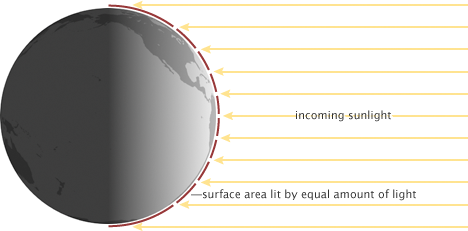
Image Reference – NASA
Cold Weather
Most portable battery banks are powered by lithium-ion batteries. Lithium-ion (Li-ion) batteries are popular because they offer a lot of advantages compared to the previous generation of nickel-cadmium batteries.
These advantages include higher energy density, lack of charge memory, and low self-discharge.
However, when it comes to charging and discharging Li-ion batteries, temperature plays a huge role.
When a battery bank is discharging (i.e., charging another device), the operating range is between -20oC and 60oC. However, when a battery bank is charging (i.e., connected to a solar charger or power generator), the operating range is between 0oC to 45oC [Reference].
This means that when you connect a device to a battery bank during winter camping, you need to ensure the minimum temperature of the device being charged is above freezing.
Many campers simply charge their devices inside of their jacket to keep everything toasty.
Solar panels do not have any issues with low temperatures!
Size Matters
Solar Panel Size vs. Power Output
There’s a direct correlation between solar panel size and power output. That’s because the larger the solar panel surface area, the more light photons it’s able to capture and convert into electricity.
Just to prove this point, I’ve plotted the total surface area of five different solar panels as a function of power output (see graph below).
As expected, there’s a linear relationship between panel area and power. This relationship, and equation, can be used to estimate the solar panel size you’ll need to bring to keep your devices charged.
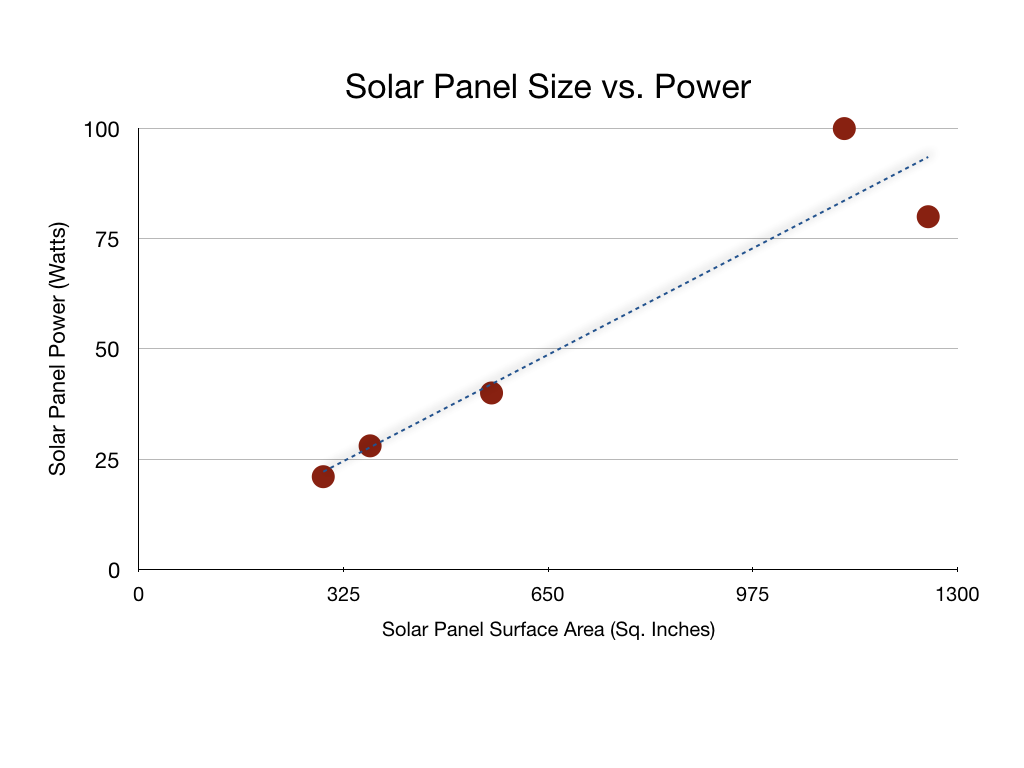
How Much Power Do You Need for Camping?
Generally, you don’t want to carry around a massive solar panel array or lots of battery banks in excess of what you need. Likewise, you don’t want to be underprepared when it comes to power.
But, how do you calculate how much power you’ll need for a given camping trip?
Well, it’s best to run through an example. Like most campers, I always bring my cell phone with me camping. The iPhone has a battery capacity of 2,815 mAh.
*** WARNING, MATH BELOW! ***
If I bring a 30,000 mAh battery bank, that means I can charge my phone from 0 to 100% around 10 times.
Instead, I could rely on the sun and bring my Anker 21W PowerPort Solar Charger. The built-in USB charging ports can typically sustain 1 Amp, which means I can recharge my phone from 0% to 100% in just under 3 hours.
But, that’s only if it’s a bright and sunny day. As soon as clouds attenuate the light, the solar panel’s output drops or can stop, drastically increasing charging times.
4 Charging Options for Camping
Accessing power when camping can be challenging. Sometimes you need on-demand power, whereas other times you can get away with a passive system.
Thankfully, there are multiple portable power options. Each options has its own unique advantages and drawbacks.
1. Battery Power Banks
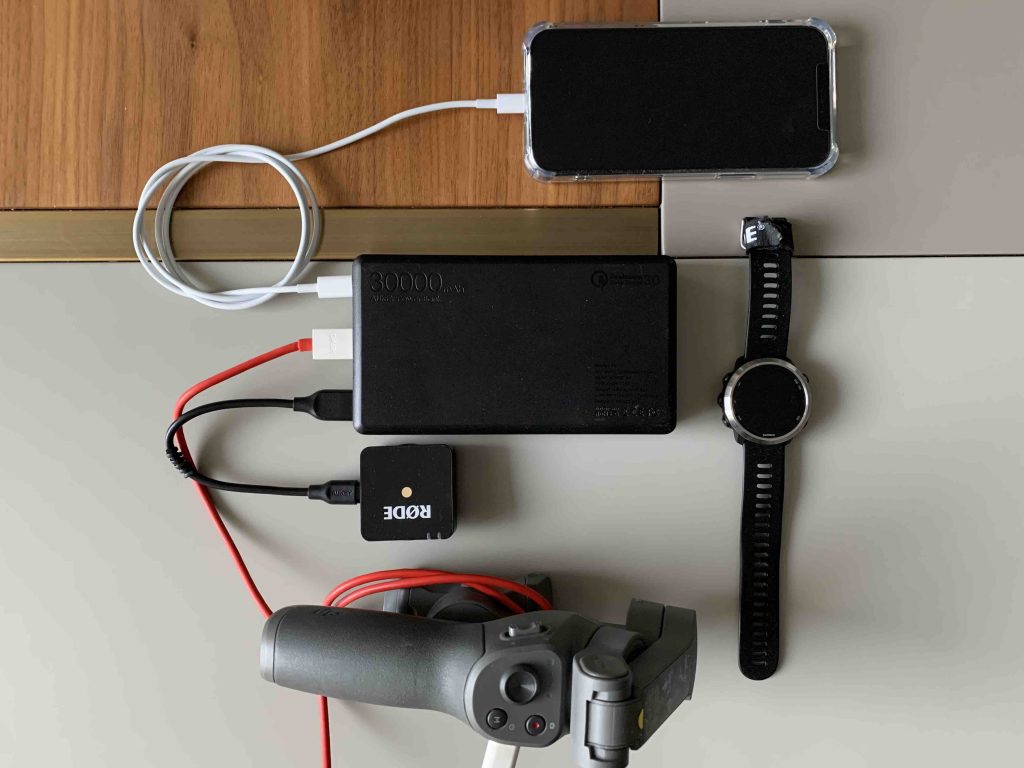
Battery banks are a great option for reliable stored power. Battery banks come in a variety of capacities ranging from 5,000 mAh up to 30,000 mAh.
However, the primary drawback to carrying a battery bank is that once it is depleted it is no longer useful. Essentially, you’ll have to carry around dead-weight.
Alternatively, you might bring too much stored power and have to lug around all these extra battery banks that take up space and weight in your pack.
So, it makes sense to bring battery banks to charge important or essential items only. For me, that means having the ability to recharge my phone multiple times during a camping trip, as well as some basic camera gear.
And, to do that, all I need to bring is my Aukey 30,000 mAh battery bank (note: only the 20,000 mAh version is now available on Amazon). It’s great because:
- I can charge up to three devices simultaneously using the dual USB ports and single USB-C port
- One of the USB ports is also rated for Qualcomm quick charge, so I can charge compatible devices extra fast
- There’s a built-in LED light which is useful when connecting devices at night
Pro-tip: Do not purchase a battery bank with a built-in solar panel (like this example). It seems like a smart idea but exposure to direct sunlight, which is great for solar panels, is extremely detrimental to lithium-ion batteries as they tend to start over-heating.
Plus, the size of the panel is so small, it’ll take days for it to recharge the battery bank. It’s just a gimmick that some manufacturer’s use to promote how “eco-friendly” their device is. It’s actually pretty useless and a waste of your money!
2. Solar Chargers
Solar chargers a fantastic, passive way to charge electronics while camping. And, depending on the size of the panels, you can charge quite a few devices and batteries at the same time.
However, similar to battery banks, you do not want to over-estimate or under-estimate how much power you want to produce.
Solar chargers work best in direct, bright sunlight so you’ll need to keep them pointed perpendicular to the sun at all times to achieve the maximum power output.
Additionally, during winter months, the solar panels won’t have much time under sunlight which means they might not be able to charge your devices.
To satisfy my camping charging needs, I purchased an Anker 21W PowerPort Solar Charger. I absolutely love it because:
- It’s compact when folded and ultra light-weight which is perfect for backcountry camping
- Comes with two USB charging ports, so I can recharge my battery bank and another device simultaneously
- I can tuck smaller devices into the charging port pouch to keep them out of direct sunlight
Pro-tip: It’s always best to charge devices directly from a solar panel if you can. This is because every time you transfer power from one device to another there is an efficiency loss.
So, instead charging your phone from a battery bank that was charged using a solar panel, plug your phone directly to the solar panel and charge the battery bank separately.
3. Portable Generators
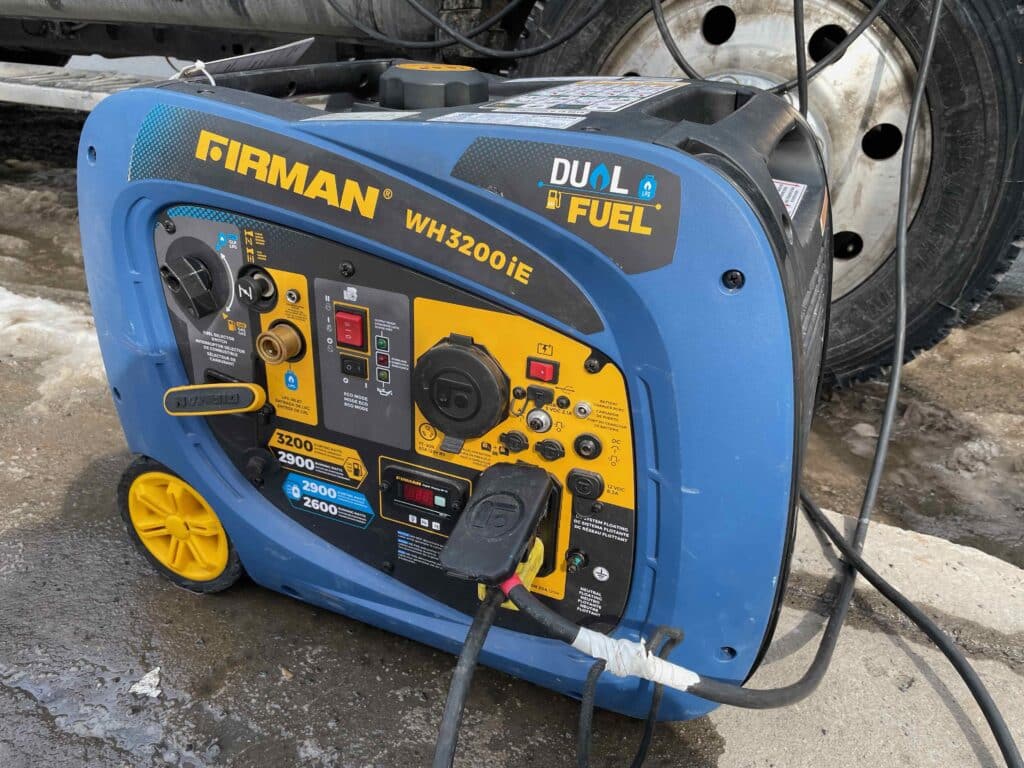
If you’re looking for reliable on-demand power, that’ll work in all climates and locations, you probably should look into a portable generator.
Portable generators are typically geared towards specific users and conditions which include:
- Campers who have set up a site for an extended period, either for work or for pleasure
- Campers at music festivals who might need access to power all day long
- Owners of campervans and RVs
- Backup power at cottages or cabins
Portable generators are fueled by gasoline, so accessing and carrying additional fuel is easy. And, it’s as quick as turning a switch and pulling the starter chord to start producing power.
Because of their compact size, portable generators can be moved and deployed quickly. But, since they rely on combustion to generate power, they aren’t the quietest. So their use in campgrounds and populated areas could be might challenging or limited.
Although I don’t currently own a portable generator, I’ve done extensive research on the best portable generators on the market. I’ve found that the Generac 2200 Watt Portable Generator is perfect for most outdoor enthusiasts. It’s very compact, quiet, and powerful.
Pro-tip: When you’re not using it for camping, portable generators are fantastic for emergency situations at home. Wind, snow or ice storms, whatever causes a blackout, you’ll always have access to power.
4. Power Inverter
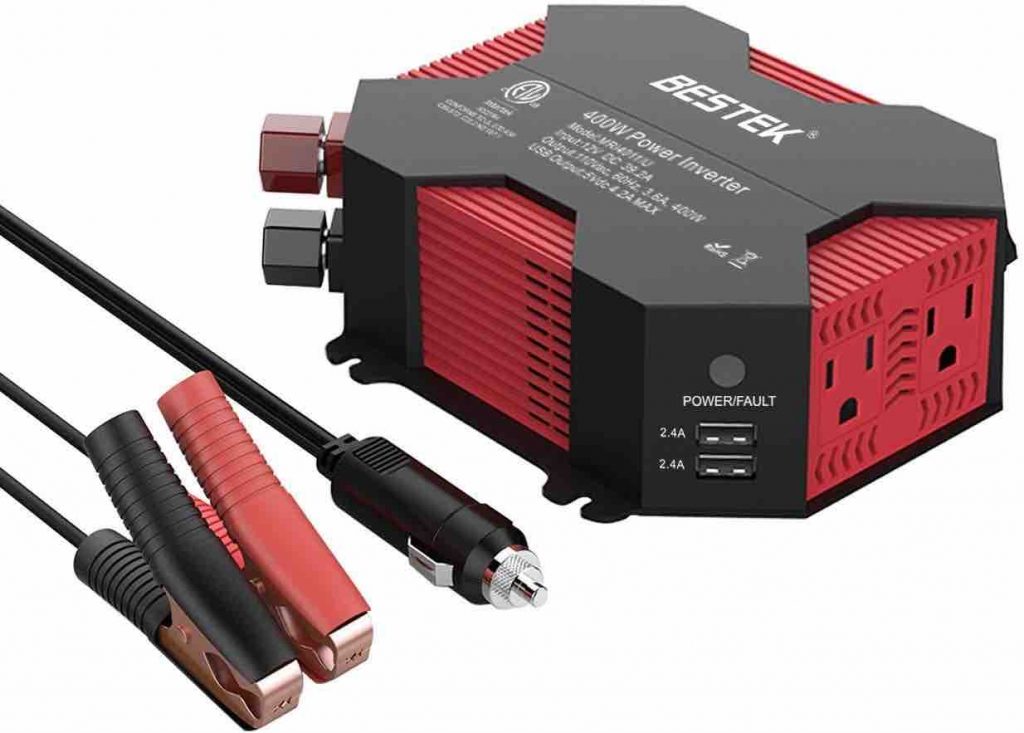
A power inverter is a device that takes direct current (DC) and converts it to alternating current (AC) which is used to power most electronic devices these days.
For car camping and road trips, a power inverter is incredibly useful. It plugs into the DC outlet of your vehicle and connects directly to the battery.
The power inverter then safely converts the power into useful power to charge pretty much any electronic device.
Personally, on our road trip around Iceland in a campervan, a power inverter was absolutely essential. While my wife and I were driving, we were able to charge multiple USB devices at once, as well as use “wall socket” type chargers for our laptops and tablet.
Because my wife and I love road trips so much, we decided to purchase a Bestek 400W car power inverter. It’s the perfect, worry-free option for road trips and car camping.
There are a lot of power inverters on the market, but I chose this specific model because:
- It plugs directly into our cars’ DC plug (cigarette lighter)
- It has 4 USB ports capable of fast charging
- Comes with 2 regular 110V AC outlets
- Includes integrated cooling fan and fuse for safety
Pro-tip: I tend to charge my battery bank using the power inverter as we drive and then use the battery bank at night when the car is off.
Just be cautious using the power inverter when the car isn’t running. You don’t want to deplete the car battery too much so it won’t start the next day!
This article contains affiliate links, which help support this blog at no cost to you!

Pingback: How to Make Water Safe to Drink for Camping - Lakes, Rivers, Streams
Pingback: How to Become a Digital Nomad – East Portland Blog
Pingback: How to Become a Digital Nomad by Cody McBride – East Portland Blog